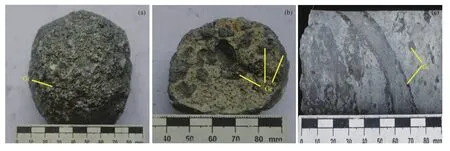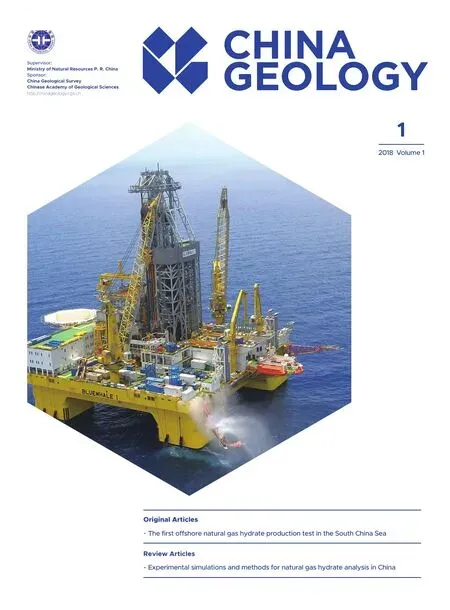A super-large graphite deposit discovered in granite rocks at Huangyangshan,Xinjiang, China
Jiang Ai, Xin-iao Lü, Zuo-wu Li, Ya-lun Wu
a China University of Geosciences, Wuhan 430074, China
b Xinjiang Branch of China National Geological Exploration Center of Building Materials Industry, Urumqi 830092, China
1. Objective
A graphite deposit has been discovered in Sujiquan,Xinjiang in 1980s, which provides detailed geological settings for the super-large graphite deposit discovered in Huangyangshan pluton with total reserves up to 7.264×109t in 2017. Outcrops of igneous rocks in the study area include Middle Devonian plagioclase granite and Late Carboniferous alkali feldspar granite that is referred to the Huangyangshan pluton, which includes the Lower Carboniferous Heishantou Formation and Jiangbasi Formation, both of which consist of volcanic-sedimentary rocks (Fig. 1). Sujiquan fault provided passage for the migration of volcanic intrusions. Graphite deposits are usually hosted by metamorphic rocks, but Huangyanshan deposits are hosted by granite rocks, which are rarely known. The Huangyangshan graphite deposit hosted by granite pluton at Huangyangshan area was discovered by Xinjiang Branch of China National Geological Exploration Center of Building Materials Industry since 2015. The graphite deposit is 160 km away from Qitai, Changji, Xinjiang, China. 8 crystalline graphite ore deposits are recognized, which has super large reserves up to 7.264×109t. The lithology of the Huangyangshan pluton is composed of 5 types: medium grained biotite granite, fine grained biotite granite, hornblende granite, medium grained arfvedsonite granite, and fine grained arfvedsonite granite. Currently, there are few studies of Huangyangshan deposit. This paper mainly introduces geological characteristics of the Huangyangshan deposit to help further researches and exploitations.
2. Methods
This project combines field investigation and sample analyzing methods. Rock samples are systematically taken from the geological sections in the field. Detailed geological characteristics of the samples are described in the field as well.Petrology and petrography studies on graphite ores and host rocks are carried out to identify lithology and mineral compositions. This paper will discuss the genesis of Huangyangshan graphite deposit with all the results in the end.
3. Results
Huangyangshan graphite deposit is consisted of 8 ore bodies. No.1 and No.2 ore bodies are hosted by hornblende granite (Table 1). The upper wall rock of these two ore bodies is hornblende granite, while the lower wall rock is fine grained biotite granite. The boundary between ore bodies and wall rocks is distinctive. No.3 and No.4 ore bodies are hosted by fine grained biotite granite. No.5 to No.8 ore bodies are hosted by medium grained biotite granite (Fig. 1).

Table 1. Characteristics of ore bodies of Huangyangshan graphite deposit (modified from Zhang et al., 2017).
The lithology of ore body is alkali feldspar granite, which consists of 60%–70% alkali feldspar, 5%–10% plagioclase,20%–25% quartz, and minor hornblende, biotite and clinopyroxene. Graphite occurs in spherulitic, nodular and veinlet structures (Fig. 2). Graphite crystals occur in flaky and colloform textures. Metallic minerals associated with graphite include pyrrhotite, chalcopyrite and ilmenite. Ore bodies were altered under strong chloritization and sericitization.Stratum inclusions were recognized in graphite ores. They are identified as sandstone and tuff under microscope, displaying resemblance to the lithology of Heishantou Formation. Graphite veins traverse graphite spherulites and nodules, implying that graphite is formed by two stages of mineralization. The first stage is magmatic hydrothermal mineralization, and thesecond stage is hydrothermal superimposition mineralization period. The first stage is the primary mineralization stage.

Fig. 1. Geological map of Huangyangshan area, Xinjiang (modified from Zhang et al., 2017).

Fig. 2. Structures of ores from Huangyangshan graphite deposit. (a): Graphite spherulite; (b): Section of graphite spherulite with graphite nodules in it; (c): Graphite vein; Gr: graphite.
Stratum inclusions are remained in the ores, indicating that the carbons involved in the formation of graphite is derived from the upper stratum. Magma assimilated carbonaceous matters from stratum during its ascending. As magmatic hydrothermal fluids separated from the magmatic melts,large amount of carbon was migrated into hydrothermal fluids. As temperature and pressure declined, crystalline graphite was precipitated from magmatic hydrothermal fluids.Therefore, Huangyangshan graphite deposit is a magmatic hydrothermal deposit rather than a magmatic deposit.
In comparison with Serrania de Ronda (Spain), Beni Bousera (Morocco), Botogol and Pogranichnoe (Russia),which are hosed by mafic-ultramafic rocks and containing few small (diameter≤5 cm) graphite spherulites, Huangyangshan super large deposit is hosted by acid rocks, containing abundant (about 90%) large (diameter≤20 cm) graphite spherulites.
4. Conclusions
Huangyangshan crystalline graphite deposit with reserves up to 7.264×109t, which is a unique super-large deposit so far.
The carbons that are consisted of graphite in Huangyangshan deposit is derived from stratum. As magma was ascending, carbonaceous matters were assimilated from stratum.Crystalline graphite was precipitated from magmatic hydrothermal fluids. Therefore, this deposit is a magmatic hydrothermal deposit instead of a magmatic deposit.
5. Acknowledgments
This paper is a contribution from The Project of China Geological Survey (DD20160058-01). The endless help from Xinjiang Branch of China National Geological Exploration Center of Building Materials Industry is much appreciated.
- China Geology的其它文章
- Three source rocks discovered in the Mid-Lower Jurassic, Dunhuang Basin in China
- Metamorphic petrology and geology in China: A review
- The oldest shale gas reservoirs in southern margin of Huangling uplift, Yichang,Hubei, China
- A discovery of Silurian tight shale gas in Jianshi, Hubei, China
- Some progress on understanding the Phanerozoic granitoids in China
- New prospecting progress using information and big data of coal and oil exploration holes on sandstone-type uranium deposit in North China

